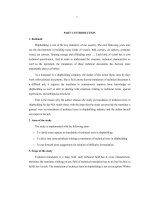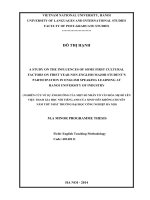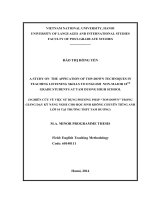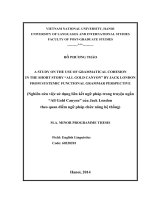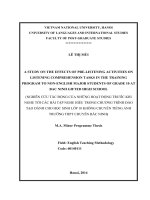Jeffrey Brautigam-5 Steps to a 5 AP European History, 2014-2015 Edition (5 Steps to a 5 on the Advanced Placement Examinations Series)-McGraw-Hill (2013)
Bạn đang xem bản rút gọn của tài liệu. Xem và tải ngay bản đầy đủ của tài liệu tại đây (20.25 MB, 355 trang )
5 STEPS TO A 5
5 STEPS TO A 5
™
SAME POWERFUL STUDY GUIDES
NEW PLATFORMS TO HELP YOU SUCCEED!
A Perfect Plan for the Perfect Score
on the Advanced Placement Exams
™
A Perfect Plan for the Perfect Score
on the Advanced Placement Exams
500 AP European History Questions to Know
by Test Day
Sergei Alschen
The perfect complement to our core prep books,
these questions are similar to the topics, format, and degree
of difficulty of those on the AP exam. Each answer comes
with a comprehensive explanation.
978-0-07-177447-5 • $14.00
AP European History Mobile Apps
With content from McGraw-Hill Education’s bestselling 5 Steps to a 5 series,
exam prep has gone mobile. Available in several AP subject areas and on
many different platforms, including the Apple iOS devices, Android (including
the Kindle Fire and Nook), BlackBerry, and Netbooks.
ISBN 978-0-07-180377-9
MHID 0-07-180377-7
5 1 8 9 5>
9 780071 803779
www.mhpracticeplus.com
www.mhpracticeplus.com
Study with us on Facebook:
www.facebook.com/aptestprep
AP, Advanced Placement, and College Board are registered trademarks of the College Entrance Examination Board,
which was not involved in the production of, and does not endorse, this product.
5
TM
5 STEPS TO A
AP European History
2014–2015
Jeffrey Brautigam, PhD
New York Chicago San Francisco Athens London Madrid
Mexico City Milan New Delhi Singapore Sydney Toronto
Copyright © 2013, 2011 by McGraw-Hill Education. All rights reserved. Except as permitted under the United States Copyright Act of 1976, no part of this
publication may be reproduced or distributed in any form or by any means, or stored in a database or retrieval system, without the prior written permission
of the publisher.
ISBN: 978-0-07-180378-6
MHID: 0-07-180378-5
The material in this eBook also appears in the print version of this title: ISBN: 978-0-07-180377-9,
MHID: 0-07-180377-7.
All trademarks are trademarks of their respective owners. Rather than put a trademark symbol after every occurrence of a trademarked name, we use names
in an editorial fashion only, and to the benefit of the trademark owner, with no intention of infringement of the trademark. Where such designations appear
in this book, they have been printed with initial caps.
McGraw-Hill Education eBooks are available at special quantity discounts to use as premiums and sales promotions or for use in corporate training
programs. To contact a representative, please visit the Contact Us page at www.mhprofessional.com.
Trademarks: McGraw-Hill Education, the McGraw-Hill Education logo, 5 Steps to a 5, and related trade dress are trademarks or registered trademarks of
McGraw-Hill Education and/or its affiliates in the United States and other countries and may not be used without written permission. All other trademarks
are the property of their respective owners. McGraw-Hill Education is not associated with any product or vendor mentioned in this book.
Credits
Public domain Soviet cartoon, page 249: Wikipedia
Public domain Punch cartoon, page 253: John Leech Archive
AP, Advanced Placement Program, and College Board are registered trademarks of the College Entrance Examination Board, which was not involved in
the production of, and does not endorse, this product.
TERMS OF USE
This is a copyrighted work and McGraw-Hill Education and its licensors reserve all rights in and to the work. Use of this work is subject to these terms.
Except as permitted under the Copyright Act of 1976 and the right to store and retrieve one copy of the work, you may not decompile, disassemble, reverse
engineer, reproduce, modify, create derivative works based upon, transmit, distribute, disseminate, sell, publish or sublicense the work or any part of it
without McGraw-Hill Education’s prior consent. You may use the work for your own noncommercial and personal use; any other use of the work is strictly
prohibited. Your right to use the work may be terminated if you fail to comply with these terms.
THE WORK IS PROVIDED “AS IS.” McGRAW-HILL EDUCATION AND ITS LICENSORS MAKE NO GUARANTEES OR WARRANTIES AS
TO THE ACCURACY, ADEQUACY OR COMPLETENESS OF OR RESULTS TO BE OBTAINED FROM USING THE WORK, INCLUDING ANY
INFORMATION THAT CAN BE ACCESSED THROUGH THE WORK VIA HYPERLINK OR OTHERWISE, AND EXPRESSLY DISCLAIM ANY
WARRANTY, EXPRESS OR IMPLIED, INCLUDING BUT NOT LIMITED TO IMPLIED WARRANTIES OF MERCHANTABILITY OR FITNESS
FOR A PARTICULAR PURPOSE. McGraw-Hill Education and its licensors do not warrant or guarantee that the functions contained in the work will
meet your requirements or that its operation will be uninterrupted or error free. Neither McGraw-Hill Education nor its licensors shall be liable to you or
anyone else for any inaccuracy, error or omission, regardless of cause, in the work or for any damages resulting therefrom. McGraw-Hill Education has
no responsibility for the content of any information accessed through the work. Under no circumstances shall McGraw-Hill Education and/or its licensors
be liable for any indirect, incidental, special, punitive, consequential or similar damages that result from the use of or inability to use the work, even if any
of them has been advised of the possibility of such damages. This limitation of liability shall apply to any claim or cause whatsoever whether such claim
or cause arises in contract, tort or otherwise.
AP
*
Prepare for Success at
Every Step in Your AP* Journey!
Prepare for Upcoming
AP Classes
This online, interactive program
builds the skills & background
knowledge you’ll need to succeed
in upcoming AP coursework and
beyond.
Prepare for
the AP Exam
This online, adaptive, diagnostic
AP Test Prep series includes 4
complete AP practice exams and
personalized study plans to help
you maximize your time leading up
to the exam.
To learn more or to purchase, visit
MHEonline.com/advancedplacement
* Advanced Placement program and AP are registered trademarks of the College Board, which was not involved in the production of, and does not endorse, these products.
CONTENTS
Preface ix
Acknowledgments xi
About the Author xiii
Introduction: The Five-Step Program
STEP 1
xv
Set Up Your Study Program
1 What You Need to Know About the AP European History Exam 3
Background Information 3
Frequently Asked Questions About the AP European History Exam 4
2 How to Plan Your Time 7
Three Approaches to Preparing for AP Exams 7
Detailed Calendar for Each Plan 9
STEP 2
Determine Your Test Readiness
3 Diagnostic Exercises 15
Introduction 15
The Multiple-Choice Questions 15
Multiple-Choice Questions Exercise 17
Answers and Explanations 18
The Document-Based Question 19
Document-Based Question Exercise 20
Suggestions and Possible Outline of a Response to the DBQ Exercise 21
The Thematic Essay Questions 22
Thematic Essay Question Exercise 23
Suggestions and Possible Outline of a Response to the
Thematic Essay Question Exercise 23
STEP 3
Develop Strategies for Success
4 The Multiple-Choice Questions 27
Introduction 27
Passive Knowledge and the Premise 28
Organizational Keys 28
The Kinds of Questions 29
About Guessing 29
Developing a Strategy 30
5 The Document-Based Question (DBQ) 33
Introduction 33
The Quality History Essay 34
❮
iii
iv
❯
Contents
Five Steps to Outlining a Short History Essay 34
Characteristics of the DBQ 36
Applying the Principles of the Quality History Essay to the DBQ
Scoring of the DBQs 37
6 Thematic Essay Questions 39
Introduction 39
Characteristics of the Thematic Essay Questions 39
Applying the Principles of the Quality History Essay to the
Thematic Essay Questions 40
Scoring of the Thematic Essays 41
STEP 4
Review the Knowledge You Need to Score High
Unit 1 1450 to the French Revolutionary and Napoleonic Era 45
7 Recovery and Expansion, 1300–1600 47
Introduction 48
Effects of the Hundred Years War 48
Disappearance of the Black Death 48
A Weakened Papacy 48
The Revival of Monarchy 49
The Rise of Spain 50
Exploration and Expansion 50
The Spanish Empire in the New World 51
Rapid Review 52
Chapter Review Questions 53
Answers and Explanations 54
8 The Renaissance, 1350–1550 57
Introduction 58
Renaissance Italian Society 58
Renaissance Values 58
Neoplatonism 59
The Renaissance Artistic Achievement 60
Knowledge of the Natural World 60
The Spread of the Renaissance 61
Rapid Review 63
Chapter Review Questions 64
Answers and Explanations 65
9 The Reformation, 1500–1600 67
Introduction 68
The Need for a Religious Reformation 68
The Lutheran Revolt 68
Creation and Spread of the Protestant Movement 69
The English Reformation 70
Calvin and Calvinism 70
Social Dimensions and the Radical Reformation 71
The Catholic Response 71
Rapid Review 73
Chapter Review Questions 74
Answers and Explanations 75
37
Contents
10 The Rise of Sovereignty, 1600–1715 77
Introduction 78
Economic Stress and Change 78
Britain: The Triumph of Constitutionalism 78
France: Absolutism 79
Central and Eastern Europe: Compromise 80
Russia: Tsarist Absolutism 80
The Baroque Style 81
Rapid Review 82
Chapter Review Questions 83
Answers and Explanations 84
11 The Scientific Revolution During the Seventeenth Century 87
Introduction 88
The Traditional View of the Cosmos 88
Alternative Traditions of Knowledge Before the
Scientific Revolution 88
Development of New Institutions 89
The Rise of Copernicanism 89
Kepler’s Laws 90
Galileo and the Value of Empirical Knowledge 91
Cartesian Skepticism and Deductive Reasoning 91
Newton and Universal Gravitation 92
Rapid Review 93
Chapter Review Questions 94
Answers and Explanations 95
12 The Enlightenment: A Cultural Movement During the
Eighteenth Century 97
Introduction 98
New Ideas About Natural Law, Human Nature, and Society 98
New Political Ideas 99
The Philosophes and Enlightened Despotism 100
Salons and Lodges 101
Skepticism, Religion, and Social Criticism 101
Science in the Enlightenment 102
The Arts in the Enlightenment 103
The Radical Enlightenment 103
The Other Enlightenment 104
Rapid Review 105
Chapter Review Questions 106
Answers and Explanations 107
13 Social Transformation and Statebuilding in the Eighteenth Century 109
Introduction 110
The Triangle of Trade 110
Breaking the Traditional Cycle of Population and Productivity 110
Market-Oriented Agriculture 111
Rural Manufacturing 111
Technical Innovations in Agriculture and Manufacturing 112
Eastern Ambition 113
War and Diplomacy 113
❮
v
vi
❯
Contents
Rapid Review 115
Chapter Review Questions 116
Answers and Explanations 117
14 The French Revolution and the Rise of Napoleon, 1789–1799 119
Introduction 120
The Ancien Régime in Crisis 120
The Moderate Phase of the French Revolution (1789–1791) 121
The Radical Phase of the French Revolution (1791–1794) 122
The Final Phase of the French Revolution: Thermidor and the
Rise of Napoleon (1794–1799) 125
Neoclassicism and the French Revolution 125
Rapid Review 126
Chapter Review Questions 127
Answers and Explanations 128
Unit 1 Summary: 1450 to the French Revolutionary
and Napoleonic Era 131
Timeline 131
Key Comparisons 132
Thematic Change/Continuity 133
Unit 2 The Napoleonic Era to the Present 135
15 Napoleonic Europe and the Post-Napoleonic Era, 1800–1848 137
Introduction 138
Post-Revolutionary France and the Napoleonic Code 138
Napoleon’s Empire 139
Neoclassicism in Napoleonic France 140
Decline and Fall of Napoleon and His Empire 140
Restoration 141
Revolution and Repression 142
Rapid Review 145
Chapter Review Questions 146
Answers and Explanations 147
16 The Second Industrial Revolution, 1820–1900 149
Introduction 150
The Factory System and the Division of Labor 150
Iron and Steel 150
New Sources of Power 151
The Railway Boom 151
The Reciprocal Nature of Heavy Industry 152
The Spread of Industrialization 152
Social Effects 153
Artistic Movements in the Industrial Age 154
Science in the Industrial Age 154
Rapid Review 156
Chapter Review Questions 157
Answers and Explanations 158
17 The Rise of New Ideologies in the Nineteenth Century 161
Introduction 162
Contents
18
19
20
21
❮
Conservatism 162
Liberalism 162
Romanticism 163
Nationalism 164
Anarchism 164
Utopian Socialism 165
Scientific Socialism and Communism 165
Social Darwinism 166
Rapid Review 167
Chapter Review Questions 168
Answers and Explanations 169
Nationalism and Statebuilding, 1848–1900 171
Introduction 172
The End of Liberal Nationalism 172
The Unification of Italy 172
The Unification of Germany 175
Nationalism in the Hapsburg Empire 176
Nationalism in France 176
Nationalism in Russia 177
Rapid Review 178
Chapter Review Questions 179
Answers and Explanations 180
Mass Politics in Europe and Imperialism in Africa and Asia, 1860–1914 183
Introduction 184
Causes of the New Imperialism 184
The Development of Mass Politics 184
The Scramble for Africa 186
Dominance in Asia 187
Rapid Review 188
Chapter Review Questions 189
Answers and Explanations 190
Politics of the Extreme and World War I, 1870–1918 193
Introduction 194
Politics of the Extreme 194
Causes of World War I 196
Basic Chronology, 1914–1915 196
Total War 197
Basic Chronology, 1916: “The Year of Bloodletting” 198
Russian Revolution and Withdrawal 198
Germany’s Disintegration and the Peace Settlement 198
Artistic Movements 199
Changes to the Scientific View of the World 199
Rapid Review 201
Chapter Review Questions 202
Answers and Explanations 203
The Interwar Years and World War II, 1918–1945 205
Introduction 206
The Interwar Years 206
vii
viii
❯
Contents
The Road to World War II 210
The Course of the War 211
Assessment and Aftermath of World War II 215
Rapid Review 216
Chapter Review Questions 217
Answers and Explanations 218
22 The Cold War and Beyond, 1945–Present 221
Introduction 222
The Nuclear Arms Race 222
The Cold War 222
The European Union 224
The Disintegration of the Iron Curtain and the Soviet Union
Nationalism and Globalization 227
Rapid Review 228
Chapter Review Questions 229
Answers and Explanations 230
225
Unit 2 Summary: The Napoleonic Era to the Present 233
Timeline 233
Key Comparisons 234
Thematic Change/Continuity 235
STEP 5
Build Your Test-Taking Confidence
AP European History Practice Test 1 239
Answers and Explanations 260
Suggestions and Outline for the DBQ 273
Suggestions and Outlines for Answers to the Thematic
Essay Questions 274
AP European History Practice Test 2 277
Answers and Explanations 297
Suggestions and Outline for the DBQ 311
Suggestions and Outlines for Answers to the Thematic
Essay Questions 312
Appendixes
Glossary of Terms 319
Bibliography 333
Web Sites 333
PREFACE
Welcome to the world of Advanced Placement (AP) European History. Whether you are, or
have been, enrolled in an AP European History course at your school or are just preparing
on your own, this guide will help you to move smoothly and confidently from your individual starting point through a five-step process that will bring you the level of preparation you
desire. Along the way, you will be evaluating your current level of preparation, evaluating your
learning strategies, reading widely, analyzing primary documents, taking practice multiplechoice tests, and writing practice essays. As you go, you will be developing the strategies and
confidence you need to score a 5 on the AP European History exam.
The five-step process is described in detail in the Introduction to this guide. Here, I simply want to urge you to enter into your preparation with enthusiasm. The intricate story of
European history is dramatic, fascinating, and extremely relevant to the world in which you
live. The information, understanding, and skills that you learn by working through this guide
will help you to do well on the AP European History exam, but they will also help you to
excel in college and to become a well-informed, critically thinking human being.
As you begin, it is important that you not think of this guide as some large book to “get
through.” This guide is a tool, and, like many tools, it can be used in a number of different
ways. You can follow it through from beginning to end, or you can jump around, using the
information and exercises contained in it in any way that suits you best. So take some time
to familiarize yourself with the contents of this guide; get a feel for how it “works.” Then,
when you are ready, read Chapters 1 and 2; they will help you to choose the mode of preparation that is right for you.
Good luck and enjoy your journey!
❮
ix
This page intentionally left blank
ACKNOWLEDGMENTS
I would like to thank Eric Dodge for putting me in touch with Grace Freedson, and Grace
Freedson for connecting me with McGraw-Hill. I would also like to thank all those who
assisted me in the preparation of this book: Ruth Mills and Del Franz for superior editing;
Stefano Fornazzari and Daraius Bharucha of the Bill Crothers Secondary School, Department
of History, Unionville, Ontario, Canada, for their excellent comments and suggestions;
Robyn Ryle for her critical reading and support; and my daughter, Grace Brautigam, for all
the times she patiently waited for daddy to “finish his book.”
❮
xi
This page intentionally left blank
ABOUT THE AUTHOR
JEFFREY BRAUTIGAM is professor of history in the Department of History at Hanover College in Hanover, Indiana, where he evaluates all requests for AP college credit and placement
in history. A recipient of a Ph.D. in history from the University of Florida, he has taught
European History at the college level for 15 years. He is the coauthor of A Student Introduction to Charles Darwin (Kendall/Hunt, 1999, ISBN 0-7872-6311-7). Professor Brautigam
is a historian who writes for students and general audiences. He is a member of the American Historical Association and the Association of Core Texts and Courses.
❮
xiii
This page intentionally left blank
INTRODUCTION:
THE FIVE-STEP PROGRAM
The Basics
If you are looking at this book, it is because you are considering taking the AP European History exam. Maybe you are enrolled in an AP European History class in your high school, or
maybe you are planning a course of study on your own. Either way, you need some help, and
you have come to a bookstore or are shopping online to find it. Right now, there are a number of guides either on the shelf or on the screen in front of you, and you are wondering about
the differences between them. The fact is, all the guides in front of you are similar in a number of ways: Each is written by an experienced history instructor who is intimately familiar
with the AP European History exam; each contains a concise review of the material you will
need to master in order to do well on the exam; and each contains a number of practice
exams and exercises to assist you in that preparation.
There is, however, one crucial difference: This book is based upon the highly successful
“5 Steps to a 5” program. If you are like the thousands of students who have used the 5 Steps
to a 5 program to successfully prepare for AP exams, it is a difference worth exploring.
Introducing the Five-Step Preparation Program
This book is organized as a five-step program to prepare you for success on the AP European
History exam. These steps are designed to provide you with the skills and strategies vital to
the exam and the practice that can lead you to that perfect 5. Here are the five steps:
Step 1: Set Up Your Study Program
In this step, you will read a brief overview of the AP European History exam and be guided
through a process to help determine which of the following preparation programs is right for you:
●
●
●
full school year: September through May
one semester: January through May
six weeks: basic training for the exam
This is covered in Chapters 1 and 2.
Step 2: Determine Your Test Readiness
In this step, you will work through a series of diagnostic exercises and questions that will
evaluate your current level of preparation and help you to devise new strategies for success.
●
●
●
Go through each diagnostic exercise step by step and question by question to build your
confidence level.
Review the correct answers and explanations so that you see what you do and do not yet
fully understand.
Evaluate your level of preparation and your current preparation strategies.
All of this is provided in Chapter 3.
❮
xv
xvi
❯
Introduction: The Five-Step Program
Step 3: Develop Strategies for Success
In this step, you will learn strategies that will help you do your best on the exam. These
strategies cover both the multiple-choice and free-response sections of the exam:
●
●
●
Learn to read multiple-choice questions: see Chapter 4.
Learn how to answer multiple-choice questions, including whether or not to guess: see
Chapter 4.
Learn how to plan and write the free-response questions, which include both documentbased questions, covered in Chapter 5, and the thematic essay questions, which are covered
in Chapter 6.
Step 4: Review the Knowledge You Need to Score High
In this step, you will learn or review the material you need to know for the test. This review
section takes up the bulk of this book and covers the material covered on the AP European
History exam:
●
●
1450 to the French Revolutionary and Napoleonic Era: see Chapters 7–14 and the Unit I
summary
the Napoleonic Era to the present: see Chapters 15–22 and the Unit 2 summary
At first glance, it may look like there is a lot of material to cover, enough to summarize
a yearlong experience in an AP European History course. Some AP courses will have covered
more material than yours, and some will have covered less, but the bottom line is that if you
thoroughly review this material, you will have studied the great majority of the material that
is tested on the exam, and you will have significantly increased your chances of scoring well.
But even more important, you will have developed successful strategies for testing well in the
field of history that will help you on both the exam and in your future college history classes.
Step 5: Build Your Test-Taking Confidence
In this step, you will complete your preparation by testing yourself on practice exams. This
guide contains two complete exams in European History, each with full answers and explanations for the multiple-choice questions and suggestions and possible outlines for answers
to the free-response essay questions. Be aware that these practice exams are not reproduced
questions from actual AP European History exam, but they mirror both the material tested
by AP and the way in which it is tested.
Appendixes of Other Helpful Information
Finally, at the end of this book, you will find additional resources to aid your preparation:
●
●
●
a glossary of key terms you are likely to encounter in your reading and on the AP European History exam
a list of Web sites related to the AP European History exam
a brief bibliography
Introduction: The Five-Step Program
❮
xvii
Introduction to the Graphics Used in This Book
To emphasize particular skills and strategies, several icons are used throughout this book.
An icon in the margin will alert you that you should pay particular attention to the accompanying text. The three icons are:
This icon indicates a very important concept or fact that you should not pass over.
This icon calls your attention to something you might want to try when attempting to answer
a particular type of question.
This icon indicates other useful information you might want to keep in mind about the
exam.
Finally, italic words indicate terms that are included in the glossary at the end of this book.
This page intentionally left blank
STEP
1
Set Up Your Study Program
CHAPTER 1
CHAPTER 2
What You Need to Know About the AP European
History Exam
How to Plan Your Time
This page intentionally left blank
CHAPTER
1
What You Need to Know About the
AP European History Exam
IN THIS CHAPTER
Summary: Familiarize yourself with the exam and get answers to frequently
asked questions.
Key Ideas
✪ The AP European History exam offers high school students the opportunity
to earn college credit.
✪ You should check with the colleges you are considering for their AP-credit
policies.
✪ The AP coordinator at your school is your contact person for the exam.
✪ The exam is divided into multiple-choice and free-response sections; each
is worth 50 percent of the total grade.
✪ The free-response section consists of three essays: a document-based
question and two thematic questions.
Background Information
The Advanced Placement Program is overseen by an organization known as the College
Board, which is involved in many facets of the college admissions process. The program
offers highly motivated high school students the opportunity to take college-level courses
while they are still in high school, and the opportunity to earn credit or advanced standing
at college or university by taking the Advanced Placement exams. The European History
program is just one of many offered in the social studies area.
❮
3
4 ❯ Step 1. Set Up Your Study Program
Frequently Asked Questions About the AP European
History Exam
Why Take the AP European History Exam?
Most students take the exam with the hope of earning college credit. Most schools will give
you college credit for a score of 4 or 5, and some will give credit for a 3. However, the policies of individual colleges and universities vary, so you should check with the schools you are
interested in attending for their specific policies.
One advantage of having a college credit in European History is that you are one class
closer to graduation, but there are a couple of other good reasons to take the exam:
●
●
First, getting a college credit for AP European History will mean that you will be able to
opt out of either a required, introductory course in European History or an elective course.
Either way, you will have greater flexibility in choosing your courses, and you will be able
to move on to the more advanced and specific courses (either in history or in some other
field) that interest you.
Second, having AP credit on your transcript can increase your chances of getting into the
school you want because it tells college admissions officers that you are a serious student
who has some experience with college-level work.
Do I Have to Take an AP European History Class to Take the Exam?
No. Taking an AP European History class at your high school is a great way to prepare, but
it is not required. The College Board simply urges students to study the kinds of skills and
subjects outlined in the AP European History Course Description. The Course Description
is available online from the College Board (www.collegeboard.com). The McGraw-Hill fivestep program is based on both the College Board Course Description for AP European
History and the Exam Guidelines, so working through this guide will help you both to
develop the relevant skills and to familiarize yourself with the relevant subject material.
Who Writes and Grades the AP European History Exam?
The exam is written by a team of college and high school history instructors called the AP
European History Test Development Committee. The Committee is constantly evaluating
the test and field-testing potential questions. The exam is graded by a much larger group of
college and high school teachers who meet at a central location in early June to evaluate and
score exams that were completed by students the previous month.
What Is on the Exam?
The format of the AP European History exam is shown in Table 1.1. The multiple-choice questions cover European history from the High Renaissance period to the present. About half of
the questions cover the period from 1450 to the French Revolutionary and Napoleonic era, with
Table 1.1
AP European History Exam Format
SECTION
TEST ITEMS
TIME LIMIT
PERCENTAGE OF TOTAL GRADE
Multiple-choice
80 questions
55 minutes
50%
15-minute Break
Free-response
3 essays
130 minutes
50%
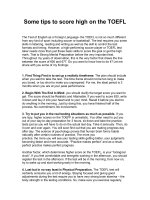
![gherghina et al - 2014 - a study on the relationship between cgr and company value - empirical evidence for s&p [cgs-iss]](https://media.store123doc.com/images/document/2015_01/02/medium_JKXoRwVO1T.jpg)
